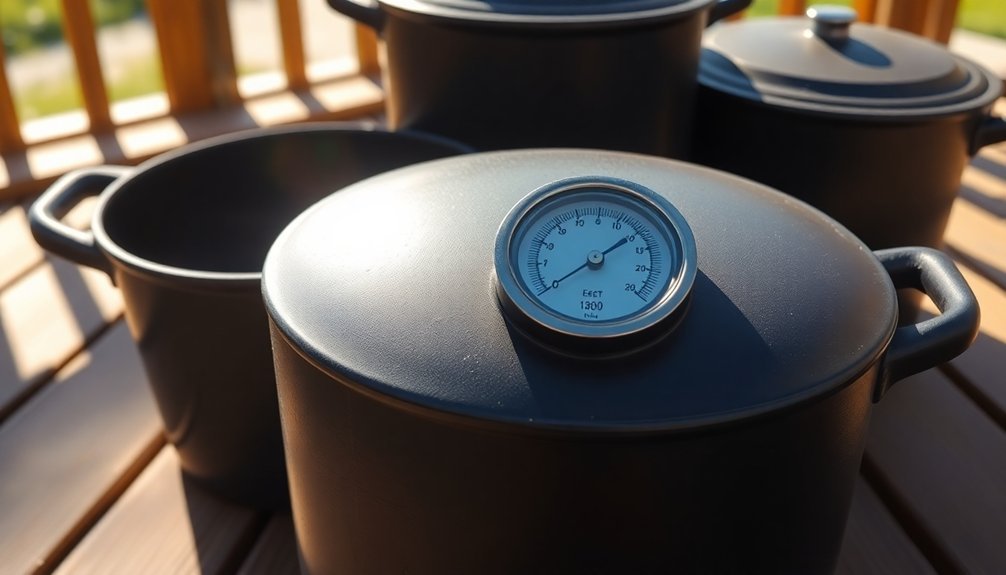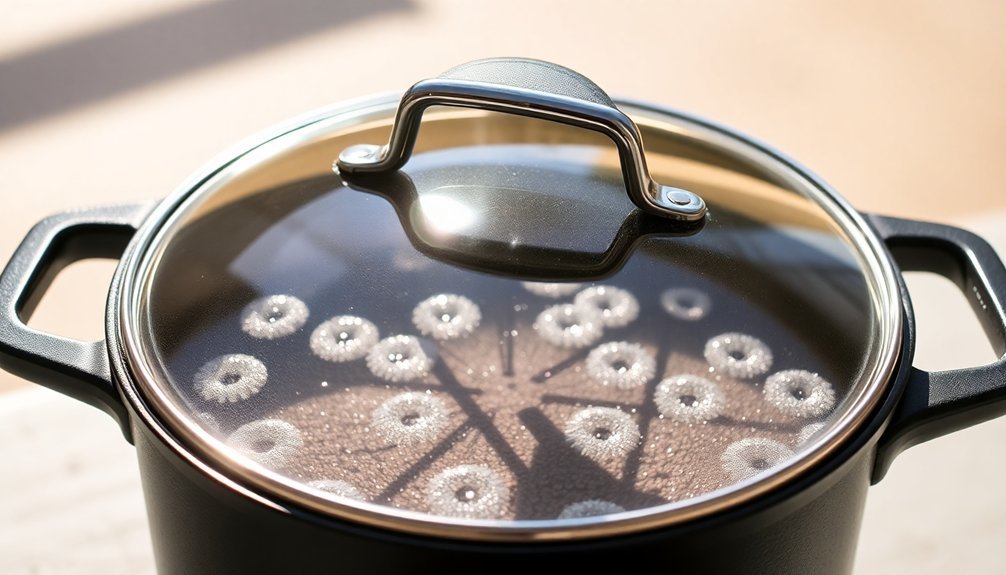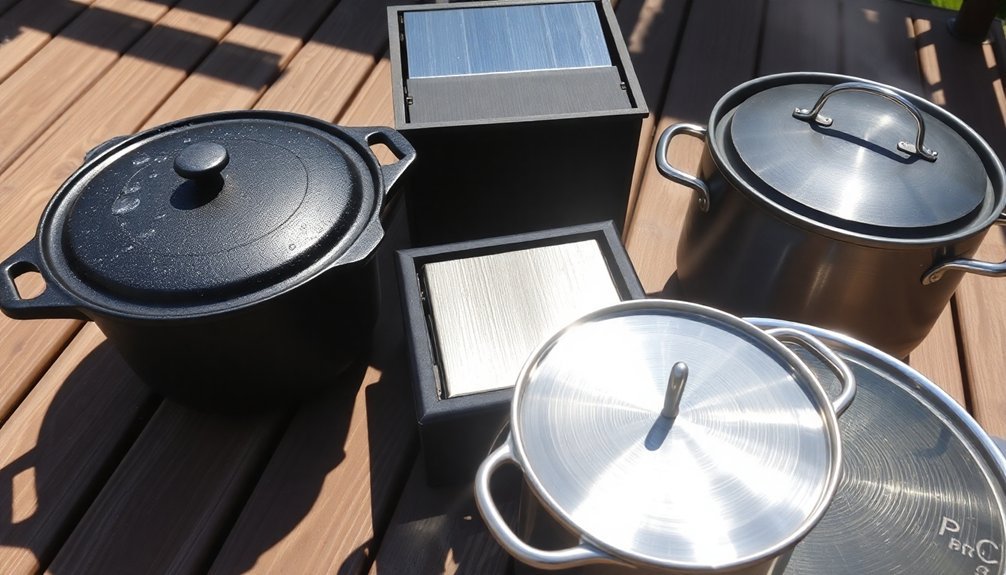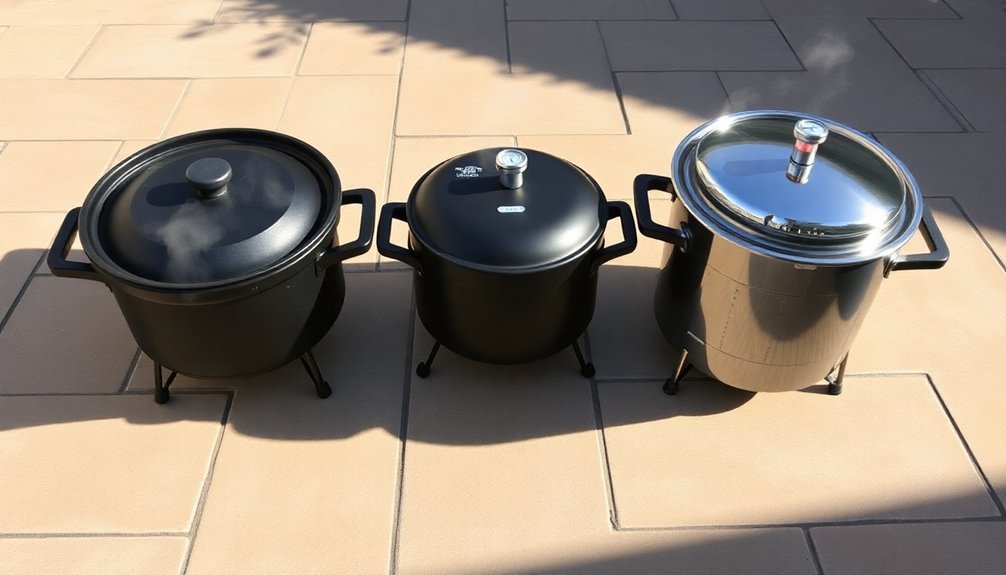For sun-powered meals, you'll want dark metal cookware with thick walls and tight-fitting lids that maximize heat absorption and retention. Black enamel, cast iron, or heavy-gauge steel pots in 5-quart sizes work perfectly in most solar ovens. Choose pots with transparent glass or plastic lids to let sunlight penetrate while trapping heat inside. The shape matters less than the color – round, oval, or rectangular all perform well when properly positioned toward the sun. Don't forget heat-resistant gloves and sturdy pot holders for safe handling. These key features will help you reveal the full potential of solar cooking.
Dark Metal Cookware Advantages

When it comes to solar cooking success, dark metal cookware proves invaluable by maximizing heat absorption and retention. Your dark pots and pans will absorb more sunlight and maintain higher temperatures longer, greatly reducing your cooking time compared to light-colored alternatives.
You'll find that dark metal cookware matches the performance of standard stovetops when used in solar parabolic cookers. It effectively concentrates the sun's rays, allowing you to deep fry, boil, and distribute heat evenly throughout your food. Heavy gauge steel provides exceptional durability and heat retention for optimal cooking results.
The versatility of dark cookware means you can use it across different solar cooker styles, from box cookers to parabolic designs. When paired with deeper parabola configurations, you'll also benefit from enhanced safety features that keep the focal point below the rim, reducing fire risks while maintaining peak cooking efficiency.
Size and Shape Guidelines
Since successful solar cooking depends heavily on proper cookware selection, choosing the right pot size and shape is essential for ideal results. A 5 quart casserole fits particularly well in most solar ovens.
You'll want to select pots that maximize your solar oven's capacity while ensuring they fit within its interior dimensions. A mid-size black enamel turkey roaster offers excellent volume, letting you cook two whole chickens at once.
You can opt for either deep or shallow pots, as both work effectively. While round pots are common, oval or rectangular shapes perform just as well.
The key is matching your pot to your cooking needs and oven specifications. Remember to reflect on the sun's movement when positioning your cookware – your pot should work with the reflector system to maintain peak heat absorption throughout the cooking process.
Essential Lid Features

The right lid can make or break your solar cooking success. You'll need a transparent glass or plastic lid that allows sunlight to pass through while trapping heat inside.
Don't use aluminum foil or reflective materials as they'll deflect precious sunlight away from your food.
Make sure your lid creates an airtight seal to maintain the greenhouse effect. A proper seal helps achieve the greenhouse effect principle that solar cookers rely on for heat retention and minimizing convection loss. You can add insulation or tape around the edges to prevent heat from escaping.
Since the sun moves across the sky, you'll want a lid that's adjustable or hinged so you can track its movement every 20 minutes for ideal exposure.
Always use pot holders when handling the lid, as it'll get extremely hot.
When checking your food, open the lid carefully to avoid steam burns and heat loss.
Heat-Retention Properties
Selecting the right pot materials plays an essential role in solar cooking success. You'll want to choose pots with a black exterior and non-reflective surface, as these absorb sunlight most effectively.
Opt for cookware that combines multiple layers of metals, such as aluminum and stainless steel, to maximize both heat retention and distribution.
The thickness of your pot matters too. Thicker materials, like cast iron, maintain steady temperatures and distribute heat evenly across the cooking surface. A glass cooking vessel will need 3.27 times more energy to heat compared to an aluminum one of similar size.
If you're using a solar cooker, thin, shallow black pots work particularly well due to their efficient heat absorption.
Remember that materials with high heat capacity, such as glass, will heat up slowly but maintain consistent temperatures once hot.
This combination of properties guarantees your sun-powered meals cook thoroughly and efficiently.
Safe Handling Equipment

Safe handling of solar cooking equipment requires three essential protective items: heat-resistant gloves, sturdy pot holders, and UV-protective sunglasses. You'll need these tools to safely manage your cooking vessels and adjust your solar oven throughout the cooking process.
| Safety Item | Purpose |
|---|---|
| Heat-resistant gloves | Protect hands when handling hot pots |
| Sturdy pot holders | Provide secure grip for cookware removal |
| UV sunglasses | Shield eyes from reflector glare |
| Adjustment rod | Allow safe lid positioning |
| Cooking bags | Guarantee food safety and heat retention |
When positioning your cookware, use a stick or rod to adjust the lid angle without direct contact. Keep children away from the cooking area unless supervised, and always place your solar oven on a stable, level surface. Remember to check your cooking setup every 10-20 minutes to maintain ideal sun exposure.
Frequently Asked Questions
Can I Use Multiple Small Pots Instead of One Large Pot?
Yes, you'll find multiple small pots work great! They'll heat more evenly, let you cook different dishes simultaneously, and fit efficiently in your solar cooker. Plus, they're easier to handle and clean.
How Do I Prevent Food From Sticking to the Bottom When Cooking?
You'll prevent sticking by preheating your pan properly, using the water droplet test, and adding cold oil to a hot pan. Keep food dry, avoid overcrowding, and let it cook until it releases naturally.
Are Ceramic-Coated Metal Pots Effective for Solar Cooking?
You'll find ceramic-coated metal pots work adequately for solar cooking, but they're not the best choice. You'd get better results with thin, dark metal pots that heat up faster and transfer heat more efficiently.
What's the Maximum Temperature My Pot Handles Should Be Rated For?
You'll want pot handles rated for at least 260°C (500°F) to be safe. Since solar cooking typically won't exceed these temperatures, most standard nonstick, stainless steel, or cast iron handles will work fine.
Should I Preheat My Pots Before Placing Food Inside Them?
You don't need to preheat pots for solar cooking since they heat gradually. However, if you're using stainless steel, a brief preheat can help prevent sticking and make cleaning easier later.
In Summary
You'll get the best results from your solar cooking by choosing dark-colored, thin-walled metal pots with tight-fitting lids. Remember to match your pot size to your meal portions and opt for wide, shallow containers when possible. Don't forget to use proper heat-resistant gloves and sturdy handles when handling your cookware. With the right equipment, you're ready to harness the sun's power for clean, efficient cooking.





Leave a Reply